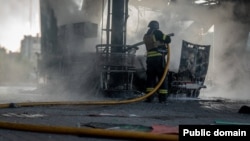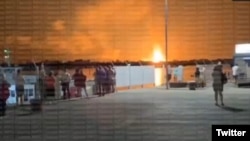When a swarm of 39 Russian drones attacked a compressor station in southern Ukraine this month, it was a sign of how Russia has shifted the focus of its attacks on Ukraine’s energy infrastructure.
The attack came less than two weeks after Ukraine signed a deal to buy natural gas from Azerbaijan for the first time. The target was critical for importing the fuel from southern Europe along the Trans-Balkan corridor and into the country.
It was the latest in a series of attacks on Ukraine’s natural gas infrastructure this year, a sharp departure from the first three years of the war when Moscow focused on crippling the country’s electric power grid.
Ukraine Scrambles For Gas
The shift has forced Kyiv to scramble for imports, including from Azerbaijan and -- indirectly -- the United States, pressuring its finances.
State-owned Naftogaz, the country’s largest gas producer and supplier, said its infrastructure has been struck more than 100 times in nine separate air assaults in 2025. Those attacks account for nearly half of all attacks on the company since Russia launched its full-scale invasion in 2022.
In February, when daily average temperatures in Ukraine were below the freezing point, Russia temporarily knocked out almost half of Ukraine’s gas production, forcing Kyiv to import 0.8 billion cubic meters (bcm) of gas.
Ukraine is now racing to fill underground storage to 13.2 bcm ahead of the winter heating season. About one-third must come from imports.
Oleksandr Kharchenko, managing director of the Energy Industry Research Center, a Kyiv-based consulting company, told RFE/RL that the domestic gas situation was “difficult but under control.”
The challenge is not securing supply but financing it. Ukraine’s National Bank estimated in April the country may need to spend as much as $2.9 billion on gas imports in 2025.
Russia's Gas Attack Pivot
“The natural gas infrastructure wasn't really the target the first several years, but now everything is game,” said Olga Khakova, an energy analyst at the Atlantic Council in Washington.
“It is an effort to destabilize energy security, not just in Ukraine, but in Europe overall. It is to create chaos within the energy industry.”
Moscow’s increased attacks on Ukrainian natural gas infrastructure have come since Russia’s contract to ship the fuel to Europe via Ukrainian pipelines -- long a contentious issue even during peaceful times -- ended on January 1.
Volodymyr Omelchenko, director of energy programs at the Razumkov Center, a think tank, told RFE/RL that the strikes are designed to undermine Ukraine ahead of winter.
“The Russian General Staff clearly understands that the greatest threat for Ukraine this winter is a shortage of natural gas, because Ukrainian gas storage facilities currently lack sufficient volumes,” Omelchenko said.
Kyiv-based political analyst Oleh Saakian said the strikes are also part of a broader Russian strategy to gain leverage as peace talks progress.
“They are attempting to create a favorable informational, propagandistic, and ideological backdrop for negotiations,” he told RFE/RL. “This is nothing but pressure on the civilian population and psychological pressure on the Ukrainian authorities.”
American LNG 'A No-Brainer'
That Russian strategy has increased the urgency for Kyiv to import and diversify suppliers. Aside from Azerbaijan, Kyiv has also signaled interest in buying US LNG, a politically sensitive move as President Donald Trump has made LNG exports a signature issue and has pressed Ukraine to reimburse the United States for military aid.
Andrew Favorov, a US-based businessman who has long worked in Ukraine’s gas industry, said signing long-term LNG contracts with US suppliers “seems like a no brainer” for Kyiv, given the potential diplomatic benefits. He suggested Ukraine could seek financing from the Development Finance Corporation, Washington’s investment arm, to secure cheap credit.
In a statement to RFE/RL, Energy Minister Svitlana Grynchuk said Ukraine is in talks with US firms but gave no details on volumes or contract length. She noted that the Odesa compressor station attacked in August is part of the infrastructure needed to import US LNG from ports in Southern Europe.
The United States is already the world’s largest exporter of natural gas with most of the fuel shipped abroad in the form of LNG. US LNG exports are expected to surge by the end of the decade as new facilities come on line.
Deals In The Making
DTEK, Ukraine’s largest privately owned energy company, said earlier this year it was in talks with US LNG companies on long-term contracts. DTEK imported US LNG for the first time in December.
Naftogaz has contracted so far this year to buy 0.44 bcm of US LNG from Polish energy firm Orlen. Hinson Peters, strategic communications manager for the Center for LNG, a US trade group, confirmed there is commercial interest from Ukrainian buyers for long-term contracts.
In the meantime, Europeans are stepping up to help Ukraine finance the purchase of fuel for the upcoming winter. The European Bank for Reconstruction and Development earlier this month announced a $580-million loan to Naftogaz for natural gas purchases.
Norway, the largest supplier of natural gas to Europe, pledged an additional 100 million dollars to Naftogaz for the same purpose.
How much more funding Ukraine will need this year to cover its domestic gas needs will depend on whether Russia continues to target its gas production, storage, and transportation assets with drones and missiles.












